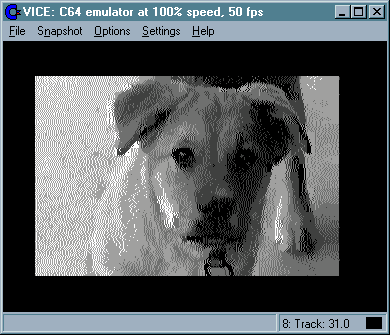|
|
Greyscale renderer for JPX
Above is a shot of my renderer displaying 'pup.jpg' - it uses standard hires bitmap mode and a floyd-steinburg error diffusion dither. For each 8x8 area of pixels, it finds the minimum and maximum grey levels of the image, and picks the two nearest VIC greys for that block and dithers using those levels. This means that only the nearest appropriate grey levels are used, but for some parts of the image it can mean some blocking effects (for example, around the pups ear on the left). Adrian Gonzales original renderer used standard bitmap mode also but used the same 2 grey levels for the entire screen. It also used dark grey & light grey which results in a loss of contrast compared with using white & black. This is the renderer I first saw and thought I could improve on, as above.
Adrian has since made two more renderers: These two modes use lots of memory (18 and 32k respectively) and require tricks to maintain the display. My renderer uses standard hires bitmap mode with no code required to maintain the display once it is rendered. C64 'laptop'A combination of a c64c keyboard/motherboard, 1581 disk drive internals and sealed 12v batteries into a compact, portable, battery powered c64 system. Built into the keyboard is a 'button joystick' - similar to the mouse pointers found on some modern laptops. The screen is presently an external 5" b/w dc tv which can sit on top of the unit. The system uses a high efficiency power supply to extend battery life, and can operate either on internal batteries, 12vdc (eg. in a car) or mains power (via 12vdc adapter).After mucking around with dozens of ideas for a case, I've finally found
a case that, with little modification, fits all the components perfectly
- a 64c case! It occured to me that I could use the case from the c64c,
but just add about a 2cm spacer between the top & botton halves. This
will leave enough space below the keyboard for the batteries, and above
the main PCB for a 1581 drive mechanism & controller. Perfect!
Lightgun for the c64Sometime in the past I managed to come across an atari lightgun, and this device works perfectly with a c64/128 using the lightpen interface on joystick port 1. I wrote an article about it which appeared in the now defunct 'Commodore Fever' paper magazine, and you can read it here.Robotics with the c64Using a c64 to control robots and other devices.(these pages still in development) |
